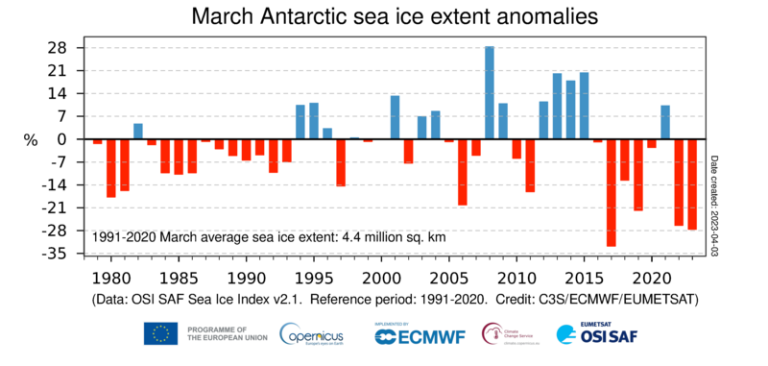It was the second joint warmest March on record: Copernicus
The world had the second joint warmest March on record and Antarctic sea ice was the second lowest on record, according to the Copernicus Climate Change Service (C3S), implemented by the European Centre for Medium-Range Weather Forecasts on behalf of the European Commission.

The monthly climate bulletins report on the changes observed in global surface air temperature, sea ice cover and hydrological variables. All the reported findings are based on computer-generated analyses using billions of measurements from satellites, ships, aircraft and weather stations around the world.
WMO uses Copernicus data as one of the six leading global datasets to compile its own State of the Global Climate reports. WMO will publish the State of the Global Climate 2022 report on 21 April.
March 2023 - temperature highlights:
- The month was jointly the second warmest March globally
- Temperatures were above average over southern and central Europe, and below average over most of northern Europe
- It was much warmer than average over a vast swathe of land covering North Africa, south-western Russia and most of Asia, where many new high temperatures records for March were set
- Much above-average temperatures also occurred over north-eastern North America, Argentina and neighbouring countries, a large part of Australia, and coastal Antarctica
- Conversely, it was much colder than average over western and central North America

March 2023 – Sea ice highlights:
- Antarctic sea ice extent was the second lowest for March in the satellite data record, at 28% below average, following a record low extent in February.
- Sea ice concentrations were much below-average in all sectors of the Southern Ocean.
- Arctic sea ice extent was 4% below average, ranking joint 4th lowest for March in the satellite data record, but also close to the three lowest extents.
- Contrasting with mostly below-average sea ice concentrations in other Arctic Ocean sectors, concentrations were well above average in the Greenland Sea.

Time series of monthly mean Antarctic sea ice extent anomalies for all March months from 1979 to 2023. The anomalies are expressed as a percentage of the March average for the period 1991-2020. Data source: EUMETSAT OSI SAF Sea Ice Index v2.1. Credit: Copernicus Climate Change Service/ECMWF/EUMETSAT.
March 2023 – hydrological variables highlights:
- In March 2023, it was wetter than average in a west-to-northeast band across northern Europe, and over Türkiye.
- Regions experiencing drier-than-average conditions during March 2023 included most of the Iberian Peninsula, where conditions were conducive to wildfires, the Alpine arc, parts of Central Europe, the eastern Balkans, and the north-western coast of the Caspian Sea.
- Beyond Europe, in March 2023 it was wetter than average over parts of the USA, several regions of Asia, the Horn of Africa, New Zealand, northern Australia, part of southern Africa, and Brazil. In many regions heavy precipitation led to flooding.
- It was drier than average over Argentina, which experienced continuing drought, southern Australia, south-western Africa and parts of Asia. In many cases these conditions were associated with warmer-than-average temperatures.










